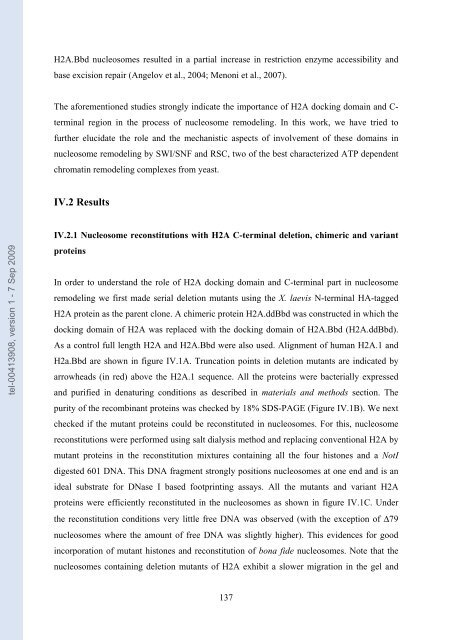Etudes sur le mécanisme de remodelage des nucléosomes par ...
Etudes sur le mécanisme de remodelage des nucléosomes par ...
Etudes sur le mécanisme de remodelage des nucléosomes par ...
You also want an ePaper? Increase the reach of your titles
YUMPU automatically turns print PDFs into web optimized ePapers that Google loves.
tel-00413908, version 1 - 7 Sep 2009<br />
H2A.Bbd nuc<strong>le</strong>osomes resulted in a <strong>par</strong>tial increase in restriction enzyme accessibility and<br />
base excision repair (Angelov et al., 2004; Menoni et al., 2007).<br />
The aforementioned studies strongly indicate the importance of H2A docking domain and C-<br />
terminal region in the process of nuc<strong>le</strong>osome remo<strong>de</strong>ling. In this work, we have tried to<br />
further elucidate the ro<strong>le</strong> and the mechanistic aspects of involvement of these domains in<br />
nuc<strong>le</strong>osome remo<strong>de</strong>ling by SWI/SNF and RSC, two of the best characterized ATP <strong>de</strong>pen<strong>de</strong>nt<br />
chromatin remo<strong>de</strong>ling comp<strong>le</strong>xes from yeast.<br />
IV.2 Results<br />
IV.2.1 Nuc<strong>le</strong>osome reconstitutions with H2A C-terminal <strong>de</strong><strong>le</strong>tion, chimeric and variant<br />
proteins<br />
In or<strong>de</strong>r to un<strong>de</strong>rstand the ro<strong>le</strong> of H2A docking domain and C-terminal <strong>par</strong>t in nuc<strong>le</strong>osome<br />
remo<strong>de</strong>ling we first ma<strong>de</strong> serial <strong>de</strong><strong>le</strong>tion mutants using the X. laevis N-terminal HA-tagged<br />
H2A protein as the <strong>par</strong>ent clone. A chimeric protein H2A.ddBbd was constructed in which the<br />
docking domain of H2A was replaced with the docking domain of H2A.Bbd (H2A.ddBbd).<br />
As a control full <strong>le</strong>ngth H2A and H2A.Bbd were also used. Alignment of human H2A.1 and<br />
H2a.Bbd are shown in figure IV.1A. Truncation points in <strong>de</strong><strong>le</strong>tion mutants are indicated by<br />
arrowheads (in red) above the H2A.1 sequence. All the proteins were bacterially expressed<br />
and purified in <strong>de</strong>naturing conditions as <strong>de</strong>scribed in materials and methods section. The<br />
purity of the recombinant proteins was checked by 18% SDS-PAGE (Figure IV.1B). We next<br />
checked if the mutant proteins could be reconstituted in nuc<strong>le</strong>osomes. For this, nuc<strong>le</strong>osome<br />
reconstitutions were performed using salt dialysis method and replacing conventional H2A by<br />
mutant proteins in the reconstitution mixtures containing all the four histones and a NotI<br />
digested 601 DNA. This DNA fragment strongly positions nuc<strong>le</strong>osomes at one end and is an<br />
i<strong>de</strong>al substrate for DNase I based footprinting assays. All the mutants and variant H2A<br />
proteins were efficiently reconstituted in the nuc<strong>le</strong>osomes as shown in figure IV.1C. Un<strong>de</strong>r<br />
the reconstitution conditions very litt<strong>le</strong> free DNA was observed (with the exception of Δ79<br />
nuc<strong>le</strong>osomes where the amount of free DNA was slightly higher). This evi<strong>de</strong>nces for good<br />
incorporation of mutant histones and reconstitution of bona fi<strong>de</strong> nuc<strong>le</strong>osomes. Note that the<br />
nuc<strong>le</strong>osomes containing <strong>de</strong><strong>le</strong>tion mutants of H2A exhibit a slower migration in the gel and<br />
137

















